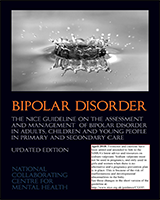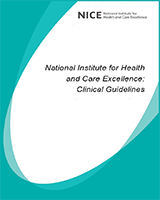All rights reserved. No part of this guideline may be reprinted or reproduced or utilised in any form or by any electronic, mechanical, or other means, now known or hereafter invented, or in any information storage or retrieval system, without permission in writing from the National Collaborating Centre for Mental Health. Enquiries in this regard should be directed to the Centre Administrator: ku.ca.hcyspcr@nimdAHMCCN
NCBI Bookshelf. A service of the National Library of Medicine, National Institutes of Health.
National Collaborating Centre for Mental Health (UK). Bipolar Disorder: The NICE Guideline on the Assessment and Management of Bipolar Disorder in Adults, Children and Young People in Primary and Secondary Care. London: The British Psychological Society and The Royal College of Psychiatrists; 2014 Sep. (NICE Clinical Guidelines, No. 185.)
April 2018: Footnotes and cautions have been added and amended to link to the MHRA's latest advice and resources on sodium valproate. Sodium valproate must not be used in pregnancy, and only used in girls and women when there is no alternative and a pregnancy prevention plan is in place. This is because of the risk of malformations and developmental abnormalities in the baby. November 2017: Footnotes for some recommendations were updated with current UK marketing authorisations and MHRA advice. Links to other guidelines have also been updated. Some research recommendations have been stood down. See these changes in the short version of the guideline.

Bipolar Disorder: The NICE Guideline on the Assessment and Management of Bipolar Disorder in Adults, Children and Young People in Primary and Secondary Care.
Show detailsThe GDG has made the following recommendations for research, based on its review of evidence, to improve NICE guidance and patient care in the future.
1. Psychological interventions for young people with bipolar depression
What is the clinical and cost effectiveness of structured psychological interventions for young people with bipolar depression?
Why this is important
There has been very little research regarding the clinical effectiveness of structured individual and group psychological interventions for children and young people with bipolar disorder. Research on unipolar depression in children and young people supports the effectiveness of cognitive behavioural therapy (CBT), interpersonal therapy (IPT) and short-term family therapy. However, there have been no published trials investigating clinical and functional outcomes for young people with bipolar depression. Given the increasing emphasis on early interventions in related conditions such as psychosis and unipolar depression, it is important to know the form of psychological therapy that can benefit young people with bipolar disorder.
A high-quality, non-inferiority randomised controlled trial (RCT) should recruit young people during an acute episode of bipolar depression who are treated with structured psychological interventions (CBT compared with IPT). Interventions should be offered over 6–9 months, with a 9-month follow-up period. Key outcomes should include clinical recovery, symptom change, personal recovery or functional outcomes at the end of treatment and at 9-month follow-up, and cost effectiveness.
2. Maintenance treatment
In the maintenance treatment of bipolar disorder, what is the relative effect on quality of life of lithium, an antipsychotic (haloperidol, olanzapine, quetiapine or risperidone), or a combination of lithium and an antipsychotic?
Why this is important
Lithium and antipsychotic medication are known to reduce the risk of relapse when used long term in people with bipolar disorder. Relapses do still occur and the response is usually to add another mood-stabilising drug. However, lithium and antipsychotics are associated with a number of side effects, some of which can adversely affect physical health. The relative effects of lithium, an antipsychotic or a combination of these drugs, regarding efficacy, tolerability, cost effectiveness and quality of life are unknown. Such information is important to people with bipolar disorder to help them make an informed choice about the treatment options available to them, and to the NHS to inform the best use of resources.
The suggested programme of research should involve a pragmatic -arm RCT comparing lithium monotherapy with antipsychotic monotherapy (haloperidol, olanzapine, quetiapine or risperidone) and a combination of lithium and an antipsychotic. The study should last at least 1 year with the primary outcome being quality of life. Symptom control, relapse, function and economic outcomes should also be measured.
3. Antidepressants combined with antimanic medication in bipolar depression
What is the clinical and cost effectiveness of fluoxetine combined with olanzapine versus an alternative selective serotonin reuptake inhibitor (SSRI) combined with olanzapine in the treatment of moderate to severe bipolar depression?
Why this is important
Bipolar depression occurs three times more frequently than mania and is associated with suicide and impaired function and quality of life. The Guideline Development Group found that the combination of fluoxetine and olanzapine was the most clinically- and cost-effective treatment for bipolar depression. Antidepressants (imipramine, paroxetine and moclobemide) alone were ineffective compared with placebo. Olanzapine alone was an effective treatment for bipolar depression, but not as effective as olanzapine and fluoxetine in combination. However, for many people some antidepressants are ineffective or cannot be tolerated. For these people the NICE clinical guideline on depression in adults3 recommends changing to another antidepressant from the same or a different class.
A two-arm non-inferiority RCT of the combination of fluoxetine and olanzapine within BNF therapeutic levels compared with an alternative SSRI and olanzapine for moderate or severe bipolar depression with a 12-week follow-up period should be carried out. The primary clinical outcome should be depression response. Secondary outcomes should be depression remission, function, anxiety symptoms, emergent mania or hypomania symptoms, other adverse outcomes, quality of life and cost effectiveness.
4. A specialised collaborative care service for people with bipolar disorder
What is the clinical and cost effectiveness of a specialised collaborative care service for people admitted to hospital with bipolar disorder compared with usual treatment delivered by generic care services?
Why this is important
There is moderate-quality evidence of the effectiveness of a specialised collaborative care service compared with usual treatment in reducing hospitalisation in two studies (from Denmark and the US). There is no overall evidence of an effect on relapse or other outcomes. An economic analysis from one study showed that better clinical outcomes were achieved at two-thirds of the overall cost of usual treatment. If similar results were obtained in England, then better care for a substantially reduced cost might be achieved.
A two-arm multicentre RCT of a specialist collaborative care service for people admitted to hospital with bipolar disorder compared with usual treatment, with follow-up of at least 2 years, is needed. Community alternatives to hospitalisation should be included. The specialist intervention should be based on collaborative care principles, including group or other psychoeducation to promote self-management, care coordination and algorithm-derived psychotropic medication (in line with this guideline) under the direction of a psychiatrist. Feasibility and acceptability development work should involve collaborating with people with bipolar disorder and professionals to demonstrate sustainable service delivery and recruitment, and identify and address possible barriers to such a service. Clinical outcomes should include time to next bipolar episode, mania and depression symptoms, function, recovery and quality of life. Economic outcomes should consider health, social care and personal costs.
5. Cognitive behavioural therapy for the long-term management of bipolar disorder
What is the clinical and cost effectiveness of face-to-face cognitive behavioural therapy (CBT) compared with internet-facilitated CBT in the long-term management of bipolar disorder?
Why this is important
The Guideline Development Group found that individual structured psychological interventions are clinically effective. Studies support the efficacy of individual CBT, but evidence for long-term benefits of internet-based interventions is less conclusive. Internet-facilitated CBT has the potential to deliver the key components of face-to-face CBT in a more cost-effective and accessible format. If this proves to be the case then increased access to cost-effective psychological care could be rapidly achieved. The proposed research programme would have 2 phases: (1) software development of internet-facilitated CBT including alpha, beta and feasibility and acceptability testing to confirm that the intervention is safe, acceptable and used by potential patients; (2) a two-arm non-inferiority RCT comparing internet-facilitated CBT with individual face-to-face CBT designed for bipolar disorder. Participants should be aged 16 years and over and be in a state of euthymia when recruited. The primary outcomes should be personal recovery and quality of life at 12-month follow-up. Secondary outcomes should be time to relapse, social and occupational functioning, and cost effectiveness.
Footnotes
- 3
NICE. Depression in Adults: The Treatment and Management of Depression in Adults. NICE clinical guideline 90. London: NICE; 2009. Available from: www
.nice.org.uk/CG90
- Psychological interventions for young people with bipolar depression
- Maintenance treatment
- Antidepressants combined with antimanic medication in bipolar depression
- A specialised collaborative care service for people with bipolar disorder
- Cognitive behavioural therapy for the long-term management of bipolar disorder
- Bipolar Disorder: The Management of Bipolar Disorder in Adults, Children and Adolescents, in Primary and Secondary Care (NICE guideline CG38)
- Surveillance report 2017: Bipolar disorder: assessment and management (2014) NICE guideline CG185
- NICE Clinical Guideline 185: Bipolar disorder: assessment and management
- Research Recommendations - Bipolar DisorderResearch Recommendations - Bipolar Disorder
- Interventions for Long-Term Management – Risk of Bias Table - Bipolar DisorderInterventions for Long-Term Management – Risk of Bias Table - Bipolar Disorder
Your browsing activity is empty.
Activity recording is turned off.
See more...
